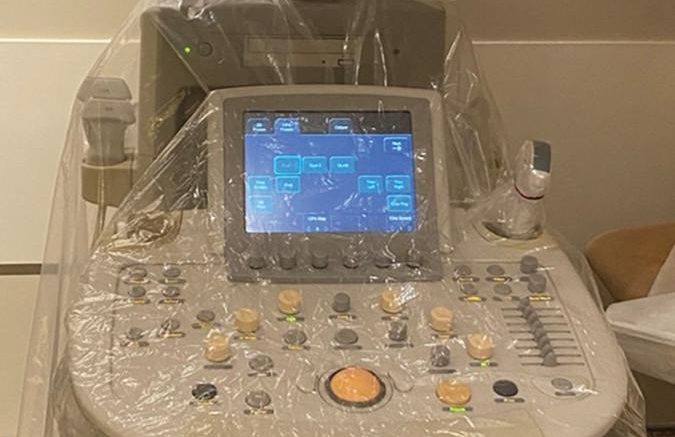Before entering the patient's room, US equipment (e.g., battery, probe, gel) is inspected to prevent failure during the examination, then covered with disposable plastic; in the room, the two imaging staff are designated nonpatient contact and direct patient contact. Courtesy of American Journal of Roentgenology (AJR)
An open-access article published in the American Journal of Roentgenology (AJR) by radiologists in Singapore recommends a number of applied updates to the workflow of diagnostic ultrasound (US) to prevent nosocomial transmission of coronavirus disease (COVID-19) to frontline U.S. service providers, who could inadvertently become vectors for onward transmission.
According to first author Apoorva Gogna and colleagues at Singapore General Hospital, "inpatient US services are segregated into the tertiary hospital and a co-located community hospital," adding that rooms with negative pressure ventilation are dedicated for isolation case scans. With all inpatient scans vetted for clinical urgency and COVID-19 status, patients not suspected of having COVID-19 arrive at a specified US imaging center via predefined route.
Suspected and confirmed COVID-19 cases, as well as intensive care patients or those in reverse isolation due to an immunocompromised state, receive portable bedside U.S. by a sonographer and an attending radiologist. "This is in contrast to our regular inpatient portable US workflow in which a trained sonographer performs the scan alone and uploads the images (usually for several patients consecutively), and the images are then sent to a dedicated radiologist for reporting," explained Gogna et al. Acknowledging that throughput is diminished when an on-duty radiologist and a sonographer work in tandem, Gogna maintains that this sacrifice ensures neither repeat scans nor additional images will be necessary.
Before entering the patient's room, U.S. equipment (e.g., battery, probe, gel) is inspected to prevent failure during the examination, then covered with disposable plastic; in the room, the two imaging staff are designated nonpatient contact and direct patient contact.
To help balance speed and clinical relevance, abbreviated scan protocols are acceptable, although Gogna points out that scanning time may not be significantly shortened. Sick patients may not be able to fully cooperate with the examination, and greater attention must be paid to safeguard against breaks in staff protection.
Meanwhile, outpatient U.S. services at Singapore General Hospital are physically segregated into two locations (general U.S. and subspecialty U.S.), and every outpatient request is vetted and prioritized according to clinical urgency. To prevent cross contamination, inpatients are not allowed to move to the outpatient scan area. Gogna advises simple steps, such as rearranging the seating in outpatient waiting areas, to help US departments reinforce social distancing guidelines.
As of June 2020, all patients and visitors to Singapore General Hospital are required to wear face masks, and present policy restricts each patient to one accompanying person.
U.S. staff, mostly segregated by location or by time, can be assigned to standby teams to cover any personnel shortage. As Gogna et al. note, "segregating manpower into redundant functional teams allows continued provision of essential services in the unfortunate event of intrahospital transmission that could require coworkers to be quarantined." Because staff segregation "does significantly affect department workload," the authors of this AJR article suggest reducing elective case listing.
Source: American Roentgen Ray Society (ARRS)

Be the first to comment on "Clinical Updates for Diagnostic Ultrasound During COVID-19 Pandemic"